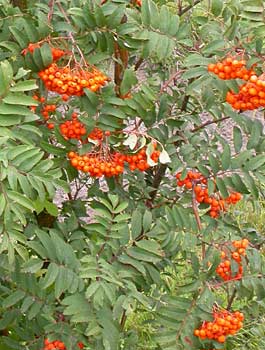Relatives
Sorbus aucuparia L. - European mountain ash, rowan tree.
Taxonomic position.
Family Rosaceae Juss. genus Sorbus L.Synonyms.
Mespilus aucuparia Scop., Pyrus aucuparia Gaertn., Aucuparia silvestris Med., Pyrenia aucuparia Clairville, Sorbus caucasigena Kom., S. sibirica Hedl., S. anadyrensis Kom., S. polaris Koehne.Morphology and biology.
Deciduous tree, 4-15 m high, less frequently shrub. Bark is gray, smooth. Buds are densely or shaggily pilose. Leaves with stipules are alternate, odd-pinnate, having 4-7 pairs of leaflets. Leafstalks are more or less densely pilose. Leaflets are oblong-lanceolate, serrate along the edges, opaque green from above, grayish from below. The inflorescence is a dense corymb, up to 10 cm in diameter. Flowers are 0.8-1.5 cm in diameter, pentamerous, with strong bitter almond-like smell. The calyx is quinquepartite, wooly, having denticles with glandular cilia along the edge. Petals are white, rounded, 4-5 mm long. Stamina, 20 in number, are equal in length with the petals. Fruits are almost globular, pome-shaped, juicy, bright orange-red, 9-10 mm in diameter. Seeds are reddish, falcate, usually 3 in number. Entomophilous. Ornito- and zoochore. Blossoms in May/June; fruits ripen in September and usually remain on the trees until early winter. 2n=34.Distribution.
Almost all Europe; Iceland; Scandinavia; Balkan Peninsula; greater part of the forest and forest-steppe zones in the European part of the ex-USSR (except southeastern areas); mountain forest belt in the Caucasus; Transcaucasia; mountainous part of the Crimea; Urals; Siberia; Far East; Kazakhstan (northern regions, Zaisan Hollow); Mongolia; Asia Minor.Ecology.
Mesophyte. Photophilous. Grows in the underbrush of coniferous and mixed forests, on forest edges and clearings, in brushwood thickets, on rocky and stony mountainsides, less frequently on meadows and steep riverbanks. Planted in afforestations, gardens, parks and orchards. Winter-hardy and drought-resistant plant, little demanding to soils.Utilization and economic value.
Medicinal, food, ornamental. Fruits serve as a remedy against scurvy and other avitaminoses, applied in alcoholic beverage industry (liqueurs, sweet brandies) and confectionary production (jams, marshmallow candies, confitures, fruit jellies). Wood is used in joinery and woodworking to produce craftwork, tools and tableware. Utilized as seedling stock for fruit-bearing plants.References:
Atlas of the areas of distribution and resources of medicinal plants in the USSR.1983. Tolmachev's A.I. (ed.). Moscow: Principal Office of Geodesy and Cartography, p.294. (inRussian).
Komarov, V.L. 1939. Sorbus L. (Flora of the USSR.) Moscow/Leningrad: Publishing House of the USSR Academy of Sciences, vol. 9, pp.376-377.
Luchnik, Z.I. 1970. Introduction of trees and shrubs in the Altai Territory. Moscow: Kolos, p.290.
Zhukovsky, P.V. 1964. Cultivated plants and their relatives. Leningrad: Kolos, p.501. (in Russian).


